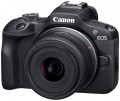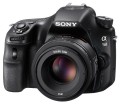Camera type
— Digital compact. This term refers to the simplest variety of modern digital cameras — those that are often called "soap dishes" in everyday life. As the name implies, these models are small in size, so most of them can be carried even in your pocket. Other specific features include a small sensor (see "Sensor Size"), a fixed lens, and a high degree of automation —
digital compacts with full manual shooting options are the exception rather than the rule. In general, this type of camera is designed mainly for amateur shooting — in most cases, the image quality is quite sufficient for domestic purposes, but such devices are usually unsuitable for professional photography.
— “Mirrorless” cameras MILC (Mirrorless Interchangeable Lens Camera — literally “mirrorless cameras with interchangeable lenses”) are compact cameras that are a kind of hybrid between compact digital cameras and “DSLRs”. They are not equipped with a system of mirrors, the viewfinder (if any) is made electronic or optical (see below), which allows you to minimize the weight and dimensions of the camera. On the other hand, such devices use matrices of the same class as in SLR cameras, which ensures high quality shooting with a minimum of noise. As the name suggests, MILC cameras also typically work with interchangeable lenses.
— Digital SLR cameras. The most technically advanced class of digital cameras. It got its name from the system of mirrors installed in the
...camera body; thanks to these mirrors, light enters the viewfinder directly through the lens (and not through the auxiliary window, as on compact cameras). As a result, the photographer sees what will be shot in real time, with high-quality colour reproduction and high brightness. It is also important that the "SLR" matrix is closed from light most of the time — the light hits it only at the time of shooting, due to which it practically does not heat up and the noise in the resulting image is minimized. The lenses of such cameras are made interchangeable, and many settings, unlike conventional digital cameras, can be set manually.
— For a mobile phone. Cameras designed to be installed on a smartphone as an external accessory and not designed for stand-alone use. Outwardly, such a device resembles a lens with a mount on the phone case; however, inside this “lens” there is a full-fledged matrix, an image processor and a Wi-Fi or Bluetooth wireless module for connecting to a smartphone. The smartphone itself, when used, simultaneously plays the role of a screen and a control device, in addition, footage can be immediately transferred to it. Technically, a similar camera can be connected to another gadget — for example, a tablet: it's not a fact that it can be fixed on the case, but the connection itself is quite possible.Sensor size
The physical size of the photosensitive element of a camera. Measured diagonally, often indicated in fractions of an inch — for example, 1/2.3" or 1/1.8" (accordingly, the second matrix will be larger than the first). Note that in such designations it is not the “ordinary” inch (2.54 cm) that is used, but the so-called "Vidiconovsky", which is less than a third and is about 17 mm. This is partly a tribute to the tradition that comes from television tubes — “vidicons” (the forerunners of modern matrices), partly a marketing ploy that gives buyers the impression that the matrices are larger than they actually are.
Anyway, at equal resolution (see Number of megapixels),
a larger sensor size means a larger size of each individual pixel; accordingly, on large sensors, more light enters each pixel, which means that such sensors have a higher photosensitivity (see Light sensitivity) and a lower noise level, especially when shooting in low light conditions.
Most often in modern cameras there are such options:
—
1/2.3" and 1/1.7". Small matrices, typical for models without interchangeable lenses — compacts and
digital ultrazooms(see "Camera type").
—
4/3. A kind of "transitional option" between small sensors of compact devices and large, but at the same time expensive "SLR" APS-C. The size of such a matri
...x is 18x13.5 mm, which gives a diagonal of 22.5 mm (approximately 4/3 of the "Vidicon" inch described above, hence the name). It is used in SLR and "mirrorless" cameras (see "Camera type"), mainly entry-level, with Four Thirds and Micro Four Thirds mounts, respectively.
— APS-C. The size of matrices of this type can vary from 20.7x13.8 mm to 25.1x16.7 mm, depending on the manufacturer. They are widely used in entry-level and mid-level SLRs, as well as "mirrorless" models.
— APS-H. Somewhat larger than the APS-C described above (the size is 28.1x18.7 mm), otherwise it is almost completely the same.
— Full frame (or APS). The size of such a matrix is equal to the frame size of a classic photographic film — 36x24 mm. It is usually equipped with professional-grade SLR cameras.
— Big frame. This category includes all types of matrices, the size of which exceeds 36x24 mm (full frame). Cameras with similar sensors belong to the so-called medium format class and are, usually, professional models of the premium level. Large matrices allow you to use a resolution of tens of megapixels, while maintaining high clarity and colour quality, however, such devices cost accordingly.Total MP
The total number of individual light sensitive dots (pixels) provided in the camera's sensor. Denoted in megapixels - millions of pixels.
The total number of MPs, as a rule, is greater than the number of megapixels from which the frame is directly built (for more details, see "Effective number of MPs"). This is due to the presence of service areas on the matrix. In general, this parameter is more of a reference than practically significant: a larger total number of MPs with the same size and effective resolution means a slightly smaller size of each pixel, and, accordingly, an increased likelihood of noise (especially at high ISO values).
Effective MP number
The number of pixels (megapixels) of the matrix directly involved in the construction of the image, in fact — the number of points from which the captured image is built. Some manufacturers, in addition to this parameter, also indicate the total number of MPs, taking into account the service areas of the matrix. However, it is the effective number of MPs that is considered the main indicator — it is this that directly affects the maximum resolution of the resulting image (see “Maximum image size”).
A megapixel is 1 million pixels. Numerous megapixels ensures high resolution of the captured photos, but is not a guarantee of high-quality images — much also depends on the size of the sensor, its light sensitivity (see the relevant glossary items), as well as hardware and software image processing tools used in the camera. Note that for small matrices, high resolution can sometimes be more of an evil than a blessing — such sensors are very prone to the appearance of noise in the image.
Maximum image size
The maximum size of photos taken by the camera in normal (non-panoramic) mode. In fact, this paragraph indicates the highest resolution of photography — in pixels vertically and horizontally, for example, 3000x4000. This indicator directly depends on the resolution of the matrix: the number of dots in the image cannot exceed the effective number of megapixels (see above). For example, for the same 3000x4000, the matrix must have an effective resolution of at least 3000*4000 = 12 million dots, that is, 12 MP.
Theoretically, the larger the size of the photo, the more detailed the image, the more small details can be conveyed on it. At the same time, the overall image quality (including the visibility of fine details) depends not only on resolution, but also on a number of other technical and software factors; see "Effective MP number" for more details.
Light sensitivity (ISO)
The sensitivity range of a digital camera matrix. In digital photography, light sensitivity is expressed in the same ISO units as in film photography; however, unlike film, the light sensitivity of the sensor in a digital camera can be changed, which gives you more options for adjusting shooting parameters. High maximum light sensitivity is important if you have to use a lens with a low aperture (see Aperture), as well as when shooting dimly lit scenes and fast-moving objects; in the latter case, high ISO allows you to use low shutter speeds, which minimizes image blur. However, note that with an increase in the value of the applied ISO, the level of noise in the resulting images also increases.
Sensor cleaning
The presence in the camera of a special mechanism for
cleaning the matrix from dust and other contaminants.
This function is found only in models with interchangeable lenses — "reflex cameras" and MILC (see "Camera type"). When replacing the lens in such cameras, the sensor turns out to be open, and the probability of its contamination is quite high; and extraneous particles on the matrix, at best, lead to the appearance of extraneous artifacts, at worst, to damage to the sensor. To avoid this, cleaning systems are provided. They usually work on the principle of ultrasound: high-frequency vibration "resets" debris from the surface of the sensor.
Note that no cleaning system is perfect — in particular, such systems are “too tough” for condensate, salt deposits and other similar contaminants. So the matrix may still need manual cleaning (ideally, in a service centre). Nevertheless, this function allows you to effectively deal with at least dust, which greatly simplifies the life of the user.
Mount (bayonet)
The type of bayonet mount — mount for interchangeable lenses — provided in a SLR or MILC camera (see "Camera type"). Bayonets come in different sizes, and interchangeable lens specifications usually indicate which mount it is designed for. Most often, mounts of different types are not compatible with each other, but there are exceptions (sometimes directly, sometimes using adapters).
Also note that one brand can use different mounts for different classes of cameras — and vice versa, one mount can be used by several manufacturers. So, Canon releases cameras with mounts
EF-M,
EF-S,
EF and
Canon RF. Leica has
Leica M,
Leica SL,
Leica TL. Nikon has in its arsenal
Nikon 1,
Nikon F,
Nikon Z. Pentax —
Pentax 645,
Pentax K, Pentax Q. Samsung offers
NX and NX-M mounts. Sony cameras have
Sony A and
Sony E, Fuji has
Fujifilm G and
Fujifilm X. And as an example of a mount used by different brands, one can cit
...e Micro 4/3, which is widespread in Olympus and Panasonic cameras.Kit lens
A lens supplied with the camera in a serial (kit) configuration. With it, the camera is ready to work literally “out of the box” - everything needed for shooting is already available, and there is no need to buy a lens separately (as is the case with the “naked body” of the
body camera). The vast majority of these are optics with a universal set of medium focal lengths and a relatively low variable aperture ratio. Often, kit lenses have rather modest characteristics, and they are intended mainly for novice users, learning the basics of photography and simple everyday shooting. But there are also other options
for whale lenses - top camera models can be equipped with fairly advanced optics. It wouldn’t hurt to clarify this point separately. We also note that the same camera can be supplied with different options for complete optics.





